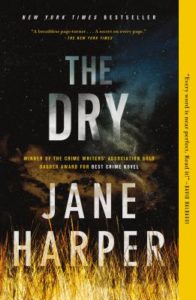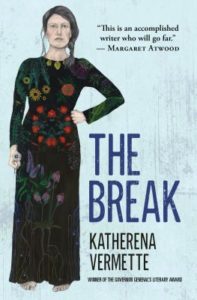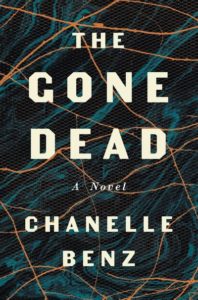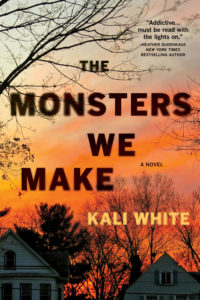Growing up in the small river town of Launceston, Tasmania, I was fascinated by how the murkiest of secrets often became casual common knowledge. Covert affairs, scammers who ripped off their own friends, family rifts, shady criminal pasts and the lies people lived with, were all discussed as casually as neighbours might swap a recipe over the fence.
My new mystery novel, Vanishing Falls, features a village tucked high in the Tasmanian rainforest. When a glamorous woman disappears from her colonial mansion on a wet winter’s night, her husband is suspected of foul play. But as the search begins, it seems everyone is hiding something, and some people will do anything, even commit murder, to keep their secrets safe. Vanishing Falls is a pretty village with a romantic history of apple-growing and a beautiful waterfall that attracts visitors. Many of the locals are wholesome, some are disreputable, but the most predatory are the most ordinary—the wolves in sheep’s clothing.
One of the things I love about a small-town setting is the ordinary, cosy atmosphere. We see carefree children playing on treelined streets, residents shopping and going about their business, rows of welcoming homes, with the odd abandoned house or overgrown lot giving a hint of the malevolence to come. As a reader, it is electrifying to know, as you read the first pages, that the serenity will be disrupted. As a writer, I love creating that disquieting mood: the contrast between the picture-perfect village and the darkness lurking beneath.
Small towns vary from a cluster of tired houses around a dusty crossroads to a quaint high street of antique and candy stores. The town could be an industrial hub that never sleeps or a row of ramshackle beach houses. The one thing small towns have in common is that when something goes wrong, everyone is affected. And no one gets away with murder.
From Australian to the USA and Canada, these ten exciting crime novels feature a small-town setting that is crucial to the unravelling of the mystery. These novelists expertly use their scalpel to conduct a forensic examination of the rot concealed in the underbelly of their chosen small towns.
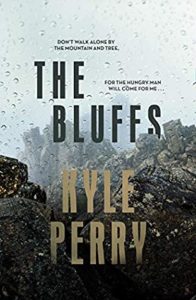
The Bluffs, by Kyle Perry (2020)
In the shadow of Tasmania’s Great Western Tiers, the people of Limestone Creek live in fear. Thirty years ago, a group of schoolgirls disappeared into the wilderness that bears down on their small town. It is believed that a mythical creature, The Hungry Man, took them. Now, a second group of schoolgirls has vanished into the hostile mountain bluffs. Like many Tasmanian towns, Limestone Creek’s meagre fortune has swung from mining to timber to tourism. This atmospheric story comes to life with arresting detail: a policeman travels from the mainland to investigate and finds a backcountry town where yards hold chicken coops, rusting cars, old sheds, hills hoists and overgrown blackberry bushes; and the air smells of diesel, woodsmoke and gumtrees. Meanwhile, Jordan Murphy, the main suspect, local drug dealer and father of one of the girls, embarks on his own hunt for answers. This intoxicating blend of supernatural and crime exposes a township riddled with corruption, abuse, sex and drugs.
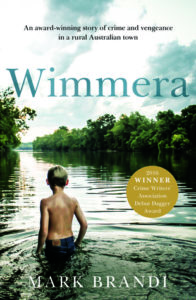
Wimmera, by Mark Brandi (2017)
Wimmera is a small Australian country town that should be a pleasant place. In the summer of 1989, two childhood friends enjoy fishing in the creek for yabbies, backyard cricket, camping, riding bikes on wide, gum-tree lined streets. But then a mysterious stranger arrives, causing a string of events that will change the boys’ lives forever. The novel moves between 1989, when the boys are eleven years old, and 2006, when a body is found in the river. This is a town with a dark, disturbing secret. Infused with nostalgic, colourful pop culture references from the eighties and a moving insight of the challenges faced by Italian immigrants, this crime novel is a snapshot of life in a quiet town where malevolence lurks behind the curtains of the most peaceful-looking homes.

The White Girl, by Tony Birch (2019)
Deane is a dying, dusty colonial country town with a slew of secrets; and none are well-kept. It’s the 1960s and Deane is segregated, with the white folk living in the heart of town, and the Aboriginal people living on the outskirts in an area that used to be the mission. They require a pass from the police station if they wish to leave. Aboriginal woman Odette Brown is singlehandedly raising her granddaughter, Sissy, a light skinned girl whose paternity is unconfirmed. With its old junkyard and dry riverbed, and the entrenched racial inequality, Deane is a hostile place to live, but Odette and Sissy have created a cosy home among a close-knit community of outcasts and misfits. However, in this literary suspense novel, the precarious peace is ruptured when a new cop arrives. As the district custodian, Sergeant Lowe will decide which ‘half-cast’ Aboriginal children should be removed from their families. When Sissy draws his attention, a harrowing cat-and-mouse chase ensues as Odette and Sissy try to escape. There is a terrifying sense of dread as Sergeant Lowe closes in.
The Dark Lake, by Sarah Bailey (2017)
The folk of close-knit Smithson, a tranquil patch of green among acres of dry farmland in Australia, learn that a killer is among them when Rosalind, a beautiful, popular English teacher is found strangled in the lake. The high school was the last place Rosalind was seen alive, following her staging of a school play. Students and teachers provide the pieces of puzzle to solve the mystery for investigating officer, Detective Sergeant Gemma Woodstock, however the policewoman is concealing her own complicated high school rivalry with the victim. This layered psychological mystery will have you guessing until the end, with a list of suspects that includes Rosalind’s mysterious, wealthy family. While police procedurals are not generally my favourite, this one stands out for its full bodied, intriguing characters. It is a twisty, riveting plot… maybe the lovely Rosalind is not as perfect as everyone thinks.
The Dry, by Jane Harper (2016)
In Australian crime fiction the untamed outback with its emptiness, strange noises, ominous silences, and menacing beauty often threatens the town folk as convincingly as any psychopath. When Detective Aaron Falk returns to his hometown following the unusual death of his best friend Luke, he is not warmly welcomed. In the drought ravaged farming town of Kiewerra, shopkeepers refuse to serve him, old friends avoid him, and he is treated as an outcast at the pub. The locals have long memories; their suspicions have not abated that he had something to do with a girl drowning in the river years ago. Luke and Aaron share a secret past which might reveal a larger truth. This outback horror—where flies feed not on the carcass of a sheep, but of a dead man—plays on the urban Australian fear of the inhospitableness of the outback. It is also a tale of claustrophobic small-town relationships where everyone is pushed to the brink. Enduring hardship can be a badge of honour for farming communities. Yet how much can they bear?
Where The Crawdads Sing, by Delia Owen (2018)
In contrast to Australian noir, where the bushland and outback are foreboding, the wild beautiful swampland of North Carolina provides sanctuary for Kya, while the town of Barkley Cove has the power to destroy her. In 1969, the town is divided by race and class. The town folk exclude the so-called Marsh Girl when she tries to be part of the community. It is the kindness of the people who live at the fringes of town—swamp boat dock owner Jumpin’ and Mabel, Kya’s friend Tate and his fisherman father—who nourish her. Beautiful descriptions of the wildlife make this novel shine, while an engrossing murder-mystery plot plays out. Kya is the central suspect when her unfaithful lover, a popular football star from a prominent white family, is found dead in the swamp. Bigoted witnesses want to incriminate her, and the story culminates with the question of whether a small town can rise above its deeply entrenched prejudices.
The Break, by Katherena Vermette (2016)
Last year I saw Katherena Vermette, a Metis writer from Treaty One territory, at the Brisbane Writer’s Festival. She spoke compellingly about the hundreds of First Nations Metis women who go missing each year, and how these cases are ignored by an indifferent police force and media. This resonated with many people in the room; First Nations people in Australia have a similar experience.
The Break is a literary mystery set in North End, Winnipeg. While this is not a small town—it is a suburb—it is separated from the rest of the city by its geographical location and poverty. A working-class neighbourhood with grand old houses, a river, and big trees, the North End is cut ‘like a scar’ by the Break, a hydro tower corridor of desolation running through the centre. It is here that a 13-year-old Metis girl is sexually assaulted, the crime witnessed by a Metis woman. The truth of the crime is revealed early on, so what unfolds is an exploration of how and why harm occurs, via the perspective of mainly local women, providing a unique lens into this unique and complex community. A haunting, frightening and compassionately told story.
Everything I Never Told You, by Celeste Ng (2014)
Middlewood is a small, peaceful college town in Ohio, where Saturday night could mean a visit to the roller rink, bowling alley or drive in. This should be a safe place to raise a family. However, it is 1977 and as a Chinese American family in this predominantly white town, history professor James Lee and his clever pretty wife Marilyn have always felt like social misfits. They attend no dinner parties, nor belong to any bridge groups, have no hunting buddies or luncheon pals. When their beloved teenage daughter Lydia is found dead in the lake, the ensuing investigation exposes the bitter, tragic effects of racism and discrimination, and highlights the question of the culpability of the town in the girl’s mysterious death.
The Gone Dead, by Chanelle Benz (2019)
Greendale is a sleepy town in the Mississippi Delta. Billie’s grandmother’s death prompts her to return to inherit her father’s ramshackle tenant house on a former plantation. He was a poet and a civil rights activist, and he died in the woods behind the house when she was a baby. As she learns more about her parents’ interracial marriage and her father’s work, she suspects that her father’s death was not an accident as she thought. This is a skillfully drawn landscape, where the ordinariness of Walmart, malls, fast food chains, gas stations, abandoned houses, tiny white clapboard churches and antique stores that double as bail bond companies, contrasts with the evocative beauty of roadside cemeteries and collapsed barns shrouded in purple blooms. This landscape has hidden much tragedy; the wealthy white neighbours’ ancestors owned the land that Billie’s ancestors sharecropped. As Billie realises that someone here knows who killed her father, the novel takes a sinister turn. Greendale is a dangerous place for a black woman to be asking these questions. This is a place where some people will do anything to hide the past.
The Monsters We Make, by Kali White (2020)
It is a hot August in 1984 and the local paperboys are going missing in this riveting mystery. Nestled between a river and vast corn fields, with abandoned coal mines and wells beneath the surface, the small town of Des Moines, Iowa, harbours many places to hide a body. The police have no leads, and the community becomes increasingly terrified. Told via the viewpoints of the investigating police officer, aspiring reporter Crystal and her frightened brother Sammy, himself a paperboy, who knows more about the abductions than he is willing to say. Terror builds as it becomes clear that the assailant could be the most ordinary, trustworthy of people – a teacher, bus driver, librarian or neighbour. The well-mannered midwestern boys are easy prey to a master manipulator. This novel is inspired by the real life Des Moines paperboy abductions, when Johnny Gosch was the first missing child to have his picture appear on a milk carton, and this gives the novel an extra chilling heart. It’s a compelling cautionary tale about the real monsters who quietly live amongst us.



